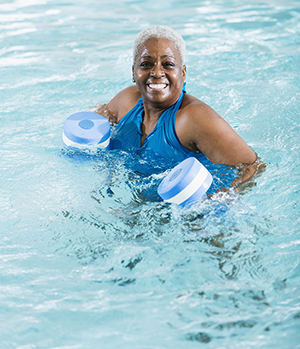Arthritis: Exercise
Exercise is important to your overall health. It is especially important for people with arthritis. Regular exercise can:
-
Keep your heart and blood vessels healthy
-
Help with weight management or weight loss
-
Improve your mood
-
Help prevent and manage health problems such as:
-
Diabetes
-
High blood pressure
-
High cholesterol
-
Depression
For people with arthritis, it offers all those benefits, and it can:
-
Lessen pain and stiffness
-
Strengthen muscles that support your joints
-
Help you to be able to do the things you enjoy
Exercise and arthritis
Exercise is an important part of any arthritis treatment plan. A complete program consists of the following 3 types of exercises:
Getting started
Talk with your healthcare provider about what is safe for you. Make sure you:
-
Pay attention to your body. Don't exercise a painful or swollen joint; switch to another activity. Follow the 2-hour pain rule: You did too much if your joint or muscle pain lasts 2 hours or more after exercising or if it is worse the next day. This doesn't mean you should stop exercising. Just do less. If the pain is bad or lasts for more than 1 or 2 days, talk to your provider.
Aerobic exercise
Aerobic exercise improves overall health and helps control weight. Choose those that don't add extra stress to your joints. For instance, walking, swimming, or bicycling.
Most people should exercise for at least 30 minutes, most days of the week. You don't have to exercise all at once. Try exercising for 10 minutes, 3 times a day, for example.
Strengthening exercises
Strengthening your muscles helps to protect your joints and prevent injuries. Try to do strengthening exercises 2 to 3 times a week:
-
These exercises can be done with exercise or resistance bands (inexpensive exercise aids that add resistance) or with light weights. Some people use soup cans as weights.
-
Isometric exercises are done by tightening the muscles without moving the joint. This may be a good way to strengthen the muscles around a stiff joint.
A physical therapist or trainer can teach you how to do these exercises.
ROM exercises
ROM exercises allow you to move each of your joints in every way they are intended to move. You should do ROM exercises for each joint 2 to 3 times a day. This will help you maintain full use of all your joints.
Sample ROM exercises
The following are just a sample of ROM exercises—one for your neck, shoulders, elbows, hips, knees, and ankles. To completely move each joint through its full range of motion, you will have to do a few exercises for each joint. A physical therapist or trainer can teach you how to do full ROM exercises for each joint.
Repeat each of these exercises 5 to 10 times. Make sure you move slowly:
-
Neck turns. Sit in a straight-backed chair. Look straight ahead. Slowly turn your head to the right, then return it to center. Repeat. Do the same thing, turning your head to the left. Repeat.
-
Shoulder raise. Lie on your back or sit in a chair. Raise one arm over your head, keeping your elbow straight. Keep the arm close to your ear. Return it slowly to your side. Repeat with your other arm.
-
Elbow stretch. Sit in a chair. If you are able, put both arms out to your sides to form a T. Slowly touch your shoulders with the tips of your fingers. Then return to the T-position. Repeat.
-
Hip stretch. Lie on your back with your legs straight and about 6 inches apart. With your foot flexed, slide your leg out to the side, then slide it back to the starting position. Repeat with your other leg.
-
Knee bend. Sit in a chair with your legs bent at the knees in front of you. Straighten one leg as much as you can, then bring it back to the floor. Repeat this 5 to 10 times. Then do the same thing with the other leg.
-
Ankle stretch. Sit with your feet flat on the floor. Lift your toes off of the floor while your heels stay down. Repeat. Then lift your heels off the floor while your toes stay down. Repeat.
Other exercise
 |
| Look for exercise classes for arthritis in your community. |
Many other exercise and activities benefit people with arthritis. It is most important to find exercise and activities that you enjoy. You might try:
For more information on exercise for arthritis, go to the Arthritis Foundation at www.arthritis.org .